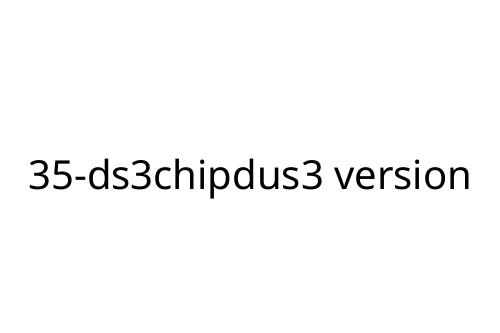35-ds3chipdus3 version
If you’re researching the 35-ds3chipdus3 version, it’s likely you’re seeking an overview: what it is, where it’s used, and how it stacks up against other options. Below, you'll find a straightforward summary to help you decide if this version meets your needs.
What Is the 35-ds3chipdus3 Version?
The 35-ds3chipdus3 version is a specific build or revision of the DS3 line of chips, frequently used in hardware engineering, computing platforms, and embedded systems. Although not as mainstream as some consumer products, it's a reference point for technical users aiming for reliability and compatibility in certain system architectures. It’s mostly found in specialized devices, custom motherboards, or as part of development toolkits.
Core Features and Technical Highlights
The most notable aspect of the 35-ds3chipdus3 version is its focus on stability and support for legacy components. Users working with older hardware appreciate this chip’s proven compatibility. It typically offers:
- Robust performance for standard computation tasks.
- Strong support for serial communication protocols.
- Power efficiency suitable for embedded applications.
- Adequate memory management for low-profile or headless environments.
- Simplified integration with existing driver stacks.
These features make the 35-ds3chipdus3 version a solid pick for projects where testing new hardware isn’t feasible, or when long-term support trumps bleeding-edge performance.
Pros and Cons
Examining pros and cons can clarify if the 35-ds3chipdus3 version fits your project.
Pros:
- Backward compatibility. Easy to slot into legacy systems without major software rewrites.
- Well-documented quirks and solutions, thanks to a moderate-sized technical community.
- Reliable for mission-critical or industrial settings where uptime matters.
- Lower power consumption compared to many newer, more demanding chips.
Cons:
- Lags behind on the latest features and speeds. Don’t expect top-tier processing power or cutting-edge protocol support.
- Compatibility may not extend to the newest operating system updates.
- Community support, while present, isn’t as active as with more common chip lines.
- Availability varies, especially if a supplier phases out old stock.
When Does the 35-ds3chipdus3 Version Make Sense?
Choose this version if you’re maintaining or extending legacy systems—particularly in environments where stability outweighs the need for the latest features. If you’re designing a new project from scratch and require state-of-the-art performance, you might want to consider a newer DS3 iteration instead.
Organizations using the 35-ds3chipdus3 version often value predictable behavior over flashy functionalities. Markets like manufacturing, process automation, and telecom infrastructure sometimes depend on chips like this due to their proven durability and vendor guarantees of long-term support.
Tips for Integrators and Developers
- Double-check your source: Stock can be inconsistent as newer versions roll out.
- Verify documentation: Older hardware often means digging through archived manuals and forums.
- Test power usage in your environment: Actual consumption can vary depending on connected peripherals.
- Don’t rely on continued updates: Build your project expecting limited future firmware or driver patches.
Conclusion
The 35-ds3chipdus3 version isn’t for everyone, but it fills a vital niche in the hardware world. If your priority is steady performance and ongoing compatibility in established systems, it’s a smart choice. Just remember its age, potential availability hurdles, and focus on proven—not flashy—functionality.


 Senior Analyst
Senior Analyst
